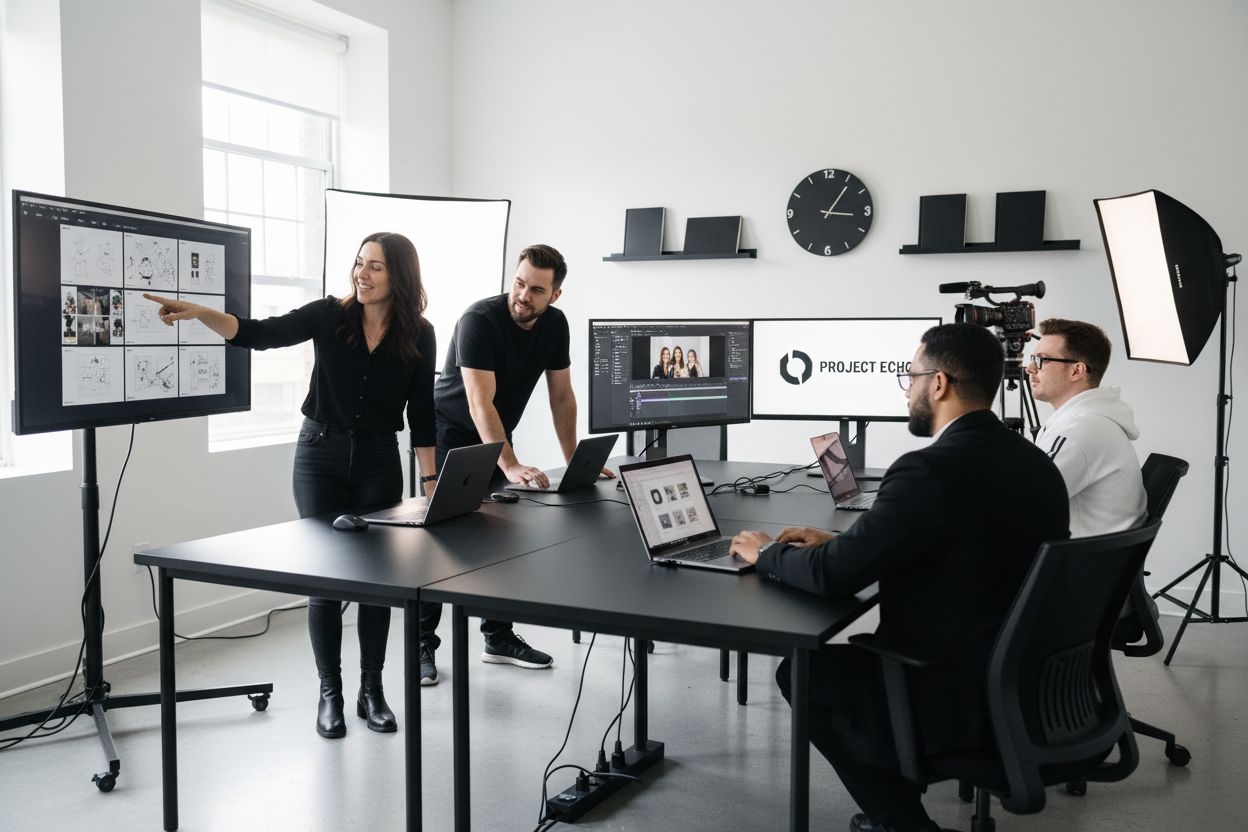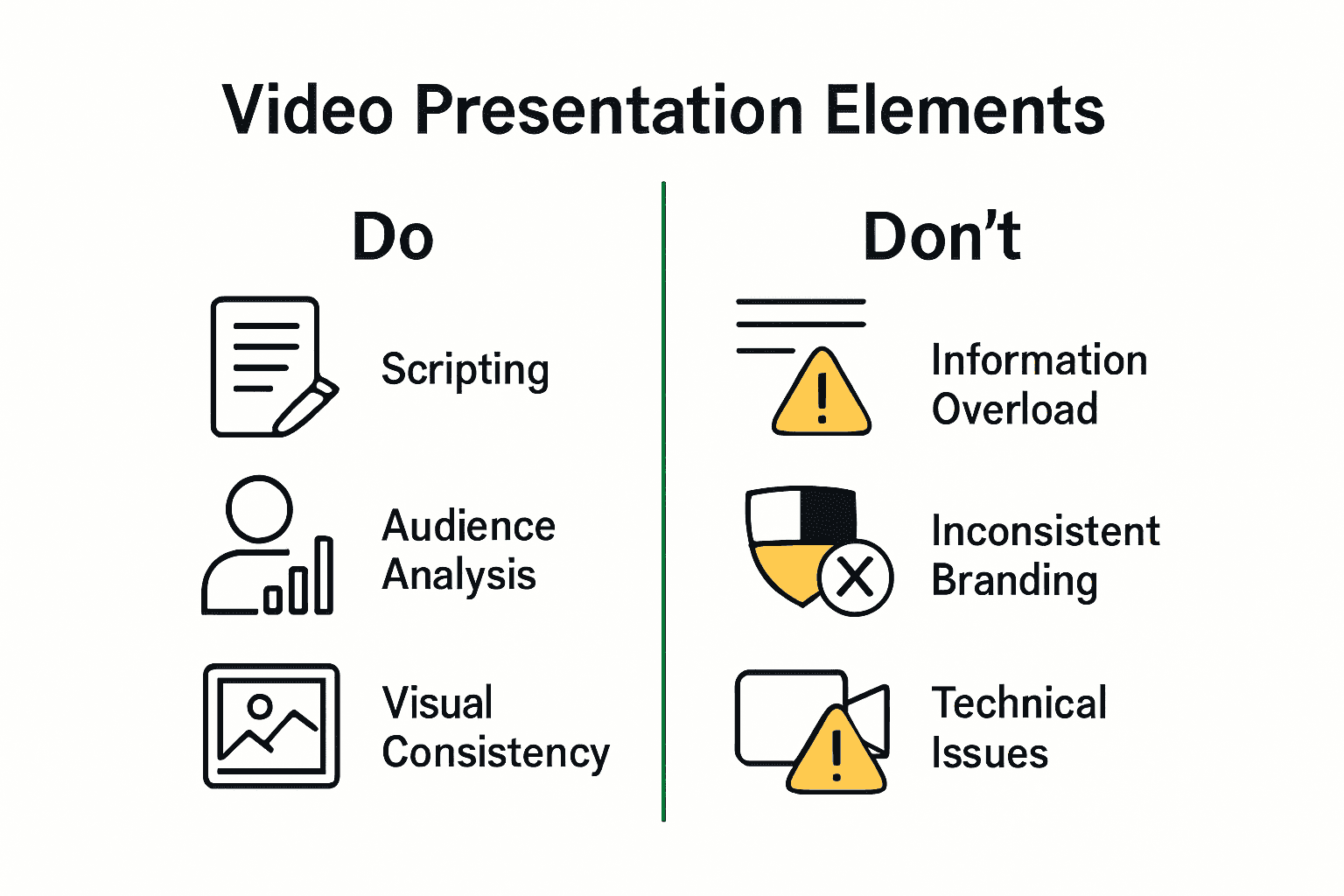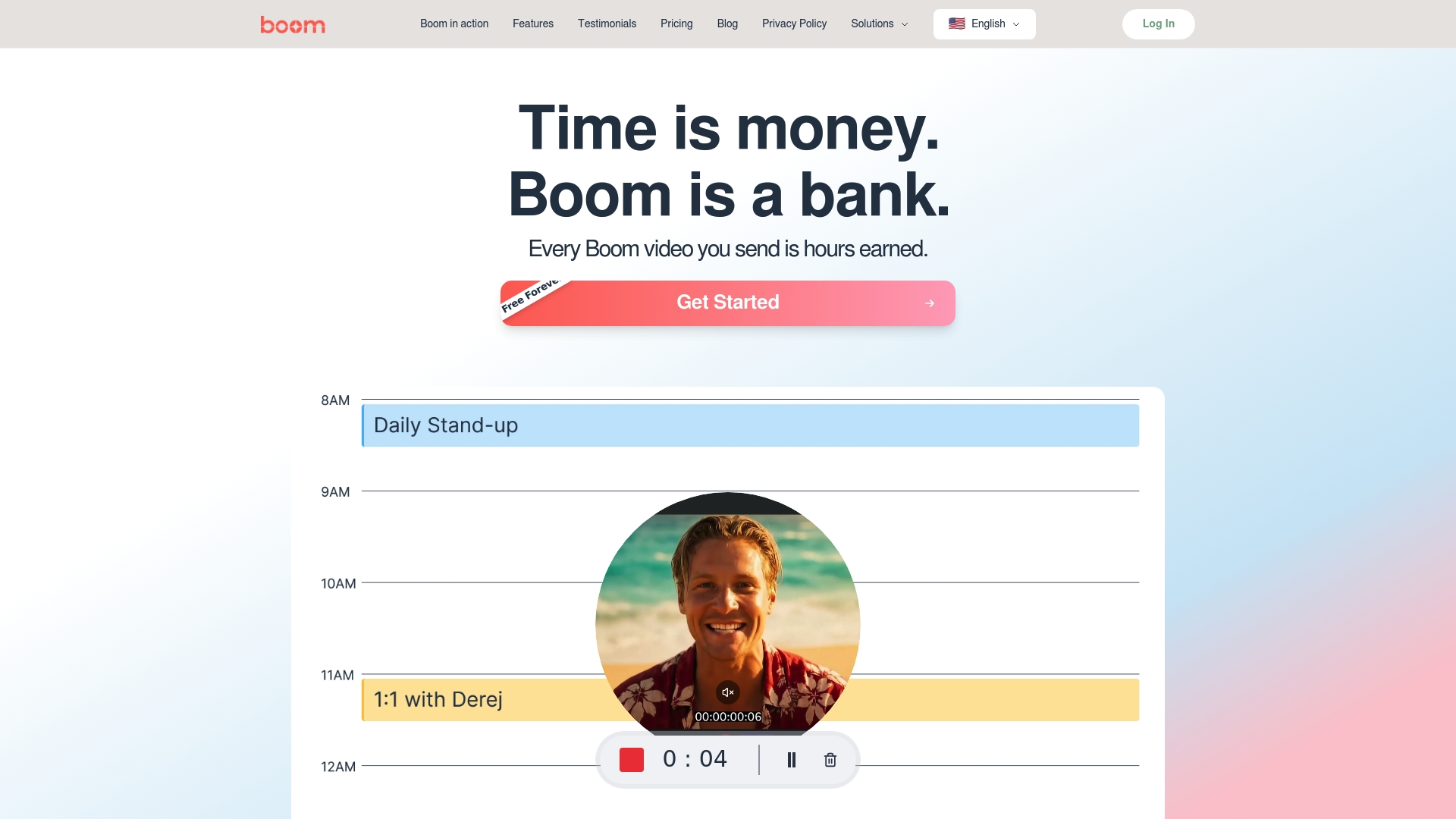How to Design Video Presentations for Impactful Results
Discover how to design video presentations with this step-by-step guide. Learn to plan, create, brand, and verify videos for engaging final results.
Daniel M
Author
How to Design Video Presentations for Impactful Results

Viewers retain up to 95 percent of a message when they watch it in a video, compared to just 10 percent when reading text. Whether you are pitching ideas or training a team, video presentations offer a powerful path to connect and persuade. Knowing how to plan, script, design, and polish your videos can turn complex information into a memorable story your audience will understand and remember.
Table of Contents
Quick Summary
| Key Point | Explanation |
|---|---|
| 1. Define clear goals first | Establish what you want to achieve with your presentation to guide content creation and messaging. |
| 2. Analyze your audience deeply | Understand audience needs, backgrounds, and preferences to tailor content effectively and enhance engagement. |
| 3. Create a structured script | Develop a concise script with a logical flow that tells a coherent story and maintains viewer interest. |
| 4. Use high-quality visuals | Select clean, professional visuals that support your message without overwhelming or distracting viewers. |
| 5. Review and polish your video | Thoroughly edit your video for clarity, coherence, and technical quality before sharing to ensure maximum impact. |
Step 1: Define your presentation goals and audience
- Step 1: Define Your Presentation Goals And Audience
- Step 2: Script And Structure Your Video Content
- Step 3: Choose Visuals And Branding Elements
- Step 4: Record Or Generate Your Video With Ai Tools
- Step 5: Review And Polish Your Video Presentation
Successful video presentations start with crystal clear goals and a deep understanding of your viewers. Your first task is mapping out exactly what you want to communicate and precisely who will be listening.
Begin by asking yourself fundamental questions about your presentation's purpose. According to research from the University of Minnesota, clearly articulating your primary message ensures audience understanding and engagement. Are you trying to inform, persuade, entertain, or inspire? Your goal will shape every aspect of your video presentation.
Next, conduct a thorough audience analysis. Research indicates that identifying your audience's needs and tailoring content to their specific interests dramatically increases presentation effectiveness. Consider these critical audience factors:
- Professional background
- Knowledge level about your topic
- Potential existing biases or preconceptions
- Specific challenges or pain points they might have
> Pro Tip: Create a detailed audience persona that represents your typical viewer. This helps you craft a more targeted and resonant presentation.
For example, if you are presenting a technical product to non technical managers, you will want to minimize jargon and focus on business value. Conversely, presenting to technical experts requires more granular detail and sophisticated explanations.
Remember that understanding your audience is not just about demographics. It is about connecting with their motivations, expectations, and learning preferences. The more precisely you can align your presentation with their needs, the more impactful your communication will be.

With clear goals and audience insights established, you are now ready to move to the next critical step: structuring your presentation content.
Step 2: Script and structure your video content
Now that you understand your audience and goals, it is time to transform those insights into a compelling video presentation script. Scripting is the backbone of your video content that will determine how effectively you communicate your message.
According to research from the University of Massachusetts, developing a concise script using conversational language and a clear narrative structure significantly enhances viewer engagement. Start by outlining your key points in a logical sequence that tells a coherent story.
A master video scripting workflow involves breaking down your content into digestible segments. Begin with a strong opening that captures attention, then progress through your main points systematically. Each section should flow naturally into the next, creating a smooth narrative arc.
Research from Columbia University recommends creating a storyboard to plan your video sequence. This visual mapping ensures your content aligns with your instructional goals and enables effective delivery. Your storyboard should include:
- Key talking points
- Visual elements or graphics
- Estimated time for each section
- Transition strategies between topics
> Pro Tip: Write like you speak. Avoid academic jargon and complex language. Your script should sound conversational and authentic.
Consider the typical attention span of your audience. For most professional presentations, aim to convey your core message within 5 to 7 minutes.
This means being ruthlessly concise and focusing on what truly matters.
Practice reading your script aloud. This helps you identify awkward phrasing, check timing, and ensure your delivery sounds natural. Many presenters find that what reads well on paper does not always translate smoothly to spoken language.
With a solid script and storyboard in place, you are now ready to move on to selecting the right visual and technical elements that will bring your presentation to life.
Here's a comparison of key scripting and structuring elements:
| Element | Purpose | Best Practices |
|---|---|---|
| Script | Guides your narrative | Use conversational language<br>Be concise |
| Key Points Outline | Organizes content | Arrange logically<br>Focus on essentials |
| Storyboard | Visualizes video sequence | Include visuals<br>Plan transitions |
| Timing | Ensures proper pacing | Aim for 5-7 minutes<br>Be concise |
| Practice Delivery | Refines performance | Read aloud<br>Check flow and tone |
Step 3: Choose visuals and branding elements
The visual landscape of your video presentation can make or break audience engagement. Your goal is to create a stunning visual experience that reinforces your message and reflects your professional brand.
According to research from the University of Colorado, selecting high-quality images and maintaining a consistent visual theme dramatically enhances the professional appearance of your video. This means every graphic, color, and design element should work together seamlessly.
Start by establishing a clear visual identity. Learn how to create branded videos that engage your audience by developing a consistent color palette, typography, and graphic style that aligns with your organization or personal brand.
Research from the University of Minnesota suggests using a combination of multimedia materials to amplify your message. Your visual toolkit can include:
- Professional photographs
- Custom graphics
- Animated transitions
- Text overlays
- Screen recordings
- Relevant video clips
> Pro Tip: Less is more. Choose clean visuals that support your narrative without overwhelming viewers.
Consider your audience and context when selecting visual elements. A technical presentation for engineers will look different from a creative pitch for marketing professionals. Your visuals should speak the visual language of your target audience.
Pay attention to technical details. Ensure all graphics are high resolution, colors are consistent, and transitions are smooth. Pixelated images or jarring visual shifts can quickly undermine your presentation's professionalism.

With your visuals carefully curated, you are now prepared to bring your presentation to life through powerful delivery and recording techniques.
Step 4: Record or generate your video with AI tools
You have your script, visuals, and strategy. Now it is time to transform your preparation into a compelling video presentation. The recording phase is where your creative planning comes to life.
According to research from Ohio State University, thorough preparation is critical before recording. This means ensuring clear audio, appropriate lighting, and a professional background that supports your message. Your recording environment matters as much as your content.
Understand the role of AI in content creation to leverage cutting-edge tools that can simplify your video production process. Modern AI technologies can help with scripting, voiceovers, editing, and even generating entire video sequences.
Research from the University of Oklahoma emphasizes keeping videos concise and well-organized. Aim to maintain viewer engagement by focusing on specific learning outcomes and avoiding unnecessary tangents. For most professional presentations, this means delivering your core message within 5 to 7 minutes.
Consider these essential recording elements:
- High-quality microphone
- Good lighting setup
- Clean background
- Stable camera or screen recording
- Consistent speaking pace
- Natural body language
> Pro Tip: Do multiple takes. Your first recording rarely captures your best performance.
If you are uncomfortable on camera, AI tools can generate realistic avatars or voiceovers that represent your message professionally. These technologies have advanced significantly and can provide a polished alternative to live recording.
Remember that authenticity trumps perfection. Small imperfections can make your presentation feel more human and relatable. Focus on clear communication and passionate delivery.
With your video recorded or generated, you are now ready to add final touches through strategic editing and refinement.
Step 5: Review and polish your video presentation
Congratulations on creating your video presentation. Now comes the critical stage of refining your work to ensure maximum impact and clarity. Polishing transforms a good video into an exceptional one.
According to research from Northern Arizona University, reviewing your video for clarity and coherence is essential. This means carefully examining every segment to ensure your message comes across precisely and professionally.
Learn how to optimize video presentations for maximum impact by approaching your editing process systematically. Break down your review into multiple focused passes.
Research from Columbia University highlights the importance of reducing cognitive processing demands. This means making your content as clear and digestible as possible. Look for opportunities to streamline your messaging and eliminate unnecessary complexity.
Consider these key editing criteria:
- Audio clarity and volume
- Visual consistency
- Pacing and timing
- Transitions between sections
- Overall narrative flow
- Technical quality of recording
> Pro Tip: Watch your video with the sound off. This helps you evaluate visual communication and catch potential distractions.
Pay special attention to technical details. Ensure your video maintains professional quality throughout. Slight imperfections can undermine your credibility and distract from your core message.
Seek feedback from colleagues or trusted peers. An external perspective can reveal blind spots you might have missed during your own review. Fresh eyes often catch nuances that you could overlook.
With your video polished and perfected, you are now ready to share your presentation with confidence and impact.
Transform Your Video Presentations with Boom
Crafting impactful video presentations starts with clear goals, strong scripting, and polished visuals — just like the steps outlined in "How to Design Video Presentations for Impactful Results." Many presenters face pain points such as tight timelines, scripted content that sounds unnatural, and inconsistent branding that weakens the message. Boom is built to solve these exact challenges by empowering you to create concise, engaging, and on-brand videos without the hassle of scheduling live meetings or complicated tools.

Elevate your presentation game with Boom's AI-powered features like auto-scripting for goal-driven content, voice-to-video recording that turns your natural speech into polished videos, and easy branding with built-in templates. Whether you want to save time on recording, improve clarity, or reach a wider audience with multilingual dubbing, Boom helps you earn back precious time and deliver better results. Start transforming your presentations today at Boom and experience why Boom is the async video tool designed for creators, remote teams, and entrepreneurs who refuse to settle for ordinary.
Explore how to create branded videos that engage your audience and learn more about the role of AI in content creation to unlock your video’s full potential.
Frequently Asked Questions
What are some key goals to define before creating a video presentation?
Start by identifying whether your aim is to inform, persuade, entertain, or inspire. Clearly articulate your primary message to guide the content structure and ensure audience engagement.
How can I analyze my audience effectively for a video presentation?
Research your audience's professional background, knowledge level, and specific challenges. Create an audience persona that captures these insights, helping you tailor content that resonates with their needs.
What elements should I include in my video presentation script?
Your script should include a strong opening, key talking points, and a logical narrative flow. Aim to keep it concise and conversational, allowing your message to be clear and engaging, ideally within a 5 to 7-minute window.
How do I select visuals that enhance my video presentation?
Choose high-quality images and maintain a consistent visual style that aligns with your brand. Ensure that visuals support your narrative without overwhelming viewers, using clean and relevant designs for your audience's context.
What technical aspects should I focus on when recording my video?
Prioritize clear audio, good lighting, and a stable camera setup. Prepare your environment to eliminate distractions, and consider multiple takes to achieve the best performance, focusing on pacing and natural body language.
How can I effectively review and polish my video presentation?
Conduct multiple focused reviews of your video, checking for audio clarity, visual consistency, and narrative flow. Seek feedback from colleagues to identify areas for improvement that you might have missed.
Recommended
About the Author
Daniel M
Contributor.
